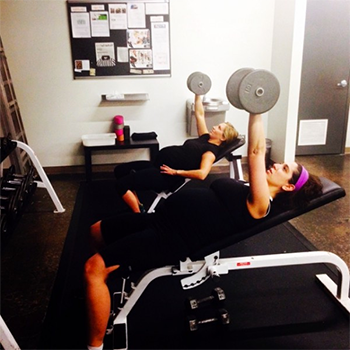Strength training is my favorite mode of exercise to recommend in pregnancy for a variety of reasons.
Strength training in pregnancy is a form of physical activity that can be modified, exercise by exercise, to your changing pregnant body, regardless of what stage of pregnancy you’re in. It can also help prepare your body to be better able to handle the physical stress of a progressing pregnancy and help to ward off back and pelvic pain. Strength training can also give you a sense of strength and power in your body at a time when you may feel out of control with how your body is changing. Additionally, studies have shown many benefits to babies of exercising moms, including better birth outcomes, healthy birth weights, and higher APGAR scores.1
If you’ve never lifted weights or have not done any resistance training prior to pregnancy before and would like to begin now, you can!
As long as you are cleared by your healthcare provider to exercise, beginning a strength training program in pregnancy is encouraged, regardless of your trimester.
Where are you going to work out?
The first thing to consider is where you want to work out.
Do you like the energy of in-person coaching or a group class? Do you like going to a gym facility? Or do you prefer exercising on your own? Is it easier on your schedule to have some equipment at home so you can complete your workouts there?

Learn The 5 Biggest Myths Of Strength Training In Pregnancy
Enter your email address to download this FREE report now.
 No option is better than any other, and I encourage you to do what feels easiest in your life. You have a wide range of options. Some women exercise only at the gym or only at home, and some do a mix of both. Some women prefer to work out with others, and some consider this their “me” time and enjoy working out by themselves.
No option is better than any other, and I encourage you to do what feels easiest in your life. You have a wide range of options. Some women exercise only at the gym or only at home, and some do a mix of both. Some women prefer to work out with others, and some consider this their “me” time and enjoy working out by themselves.
From my experience, many moms will continue to exercise later into their pregnancy if they have some basic equipment at home (dumbbells, resistance bands, mini resistance bands) and don’t have to expend extra energy or make an effort to get to the gym during the last weeks of pregnancy.
What exercises are best to do in pregnancy?
The beauty of prenatal strength training is that you have so many exercise options at your disposal. Compared to running or biking, for example, which are more difficult to modify further into your pregnancy, strength training allows you to keep doing a variety of full body exercises using some simple modifications.
 You don’t need to feel limited or that you need to avoid a bunch of different moves. Here are a few tips to choosing effective exercises in pregnancy workouts:
You don’t need to feel limited or that you need to avoid a bunch of different moves. Here are a few tips to choosing effective exercises in pregnancy workouts:
- It feels good on your body and doesn’t cause any pain or discomfort.
- Your abdominal muscles and pelvic floor feel supported, and you’re not experiencing any sensations of pressure outwards on your belly or downwards onto your pelvic floor.
- It feels moderately challenging, but doesn’t feel like you’re pushing your body to failure on any reps.
There are more nuances to it, and if at all possible, I recommend seeking out a highly qualified prenatal fitness coach to design a fitness program for you.
Here are some examples of exercises you can include in your prenatal strength training program:
Lower Body Exercises:
- Bodyweight Squat
- Goblet Squat
- KB Deadlift
- Static Lunge/Split Squat
Upper Body Exercises:
- 1-Arm Cable/Band Row
- Close Grip Lat Pulldown
- Face Pull
- Biceps Curl
Core Training Exercises:
- Tall Kneeling Pallof Press
- Bird Dog
- Side Plank
- 1-Arm Farmer Carry
What should your training program look like?
I generally recommend you strength train one to three days per week during pregnancy. If you are just beginning your first phase of strength training, start with one to two days per week. You can add another day of strength training after you’ve had a good four to eight weeks of consistent workouts, if that works for your body and your life.
The average duration of your workout including a dynamic warm-up, your strength training circuits, and a cool down will likely be 30 to 45 minutes. Of course, if you only have time for 20 minutes, you can do an effective workout in that amount of time, too.
There are multiple ways you can design the specific strength training portion of your workout. I like to choose five to eight exercises per workout session.
Here is one example of what a workout session might look like for one of my clients:
1A. Lower Body Exercise
1B. Upper Body Exercise
2A. Upper Body Exercise
2B. Lower Body Exercise
3A. Core Exercise
3B. Core Exercise
In each group (1, 2, and 3) do exercise A and exercise B in a superset format. This means that you’ll perform exercise A, take a 30-second (or longer) rest, then do exercise B,, and then rest between 60 and 90 seconds before starting your next superset.
Perform eight to 12 reps (or 20 to 30 seconds) of each exercise, and repeat the superset for two to three rounds before moving on to the next superset.
As I would advise most of my clients, you can rotate through two different full-body strength training workouts per week: a Workout A and a Workout B. The exercises in each workout can be similar in design, but use different variations. You can work on these specific workouts for four weeks and then progress and adapt based on how your body is changing at that specific phase of pregnancy.
Are there any warning signs you need to be aware of?
Pregnancy is a great time to really tune in to what your body is telling you. Do not ignore subtle hints from your body. If you think something feels weird or “off” in an exercise, take it as a sign to modify the exercise.
For example, if you feel like you cannot support your belly well enough in a pushup, you can change it to a Standing Cable or Band Chest Press, so that you’re performing the same pressing movement, but in a better position for your body.
Remember that there is no pregnancy exercise “badge of honor.” You don’t have to be pushing yourself to fatigue, or finishing the workout and feeling like you need to lie on the floor to catch your breath.
You can challenge yourself appropriately, but I recommend you gauge your physical effort on a scale. On a scale from one to 10, the majority of your workout should feel like a six or seven in terms of intensity.
Intense, all-over body soreness is not a good sign of a great workout. You do not need to be chasing muscle soreness to feel like you did a hard enough workout. Some muscle soreness is completely normal, but if you’re struggling to walk for three days following each workout, be sure to reduce the intensity or the weight you’re using.
If you are experiencing any other signs or symptoms after your workout, such as spotting or pain, speak to your health care provider immediately.
Above all, have fun! Don’t let these words of caution scare you. Strength training in pregnancy is an incredible way to connect with your body and your baby, and to prepare for birth and postpartum recovery.
Being a parent is a hugely physical task, from the get-go, so building strength and fitness throughout pregnancy will serve you well.
Smart strength training is an integral piece of the healthy pregnancy equation. Unfortunately there are still a ton of myths out there about strength training during pregnancy—but we can help!

Learn what are the 5 biggest myths of strength training in pregnancy! In this FREE report, we bust the five biggest myths and give you the TRUTH so you can have a strong, happy, and safe pregnancy.
(Make sure you read all the way through because #4 is super important!)
Click to grab our FREE Pregnancy Strength Training Myths Report
References
- May L.E., Physiology of Prenatal Exercise and Fetal Development, 2012, VIII, pp 11-14. http://www.springer.com/us/book/9781461434078
The post Why (and How) You Should Start Exercising In Pregnancy appeared first on Girls Gone Strong.






